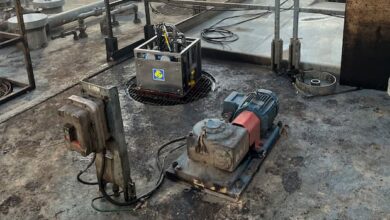Integration enables deepwater MPD solution with a single control system
High levels of integration also enable small size, light weight of riser joint, which can be picked up and deployed in a single lift
By Eva Vigh, Editorial Coordinator

Schlumberger has introduced the industry’s first complete deepwater MPD integrated solution that uses only one control system and requires fewer personnel to operate. The system features a riser joint – including a rotating control device (RCD), a slim-line annular blowout preventer and flow spool – that weighs just over 80,000 lb and measures 40-ft long, making it the shortest and lightest available on the market, according to Bas Liezenberg, DPM Deepwater Product Champion, M-I SWACO, a Schlumberger company. “Our goal was to reduce the total cost of ownership,” he said.
The small size and light weight of the riser joint is enabled by a high level of integration, where all components of the riser joint were integrated into one design. “The MPD riser joint is operated through a single umbilical, which is also an integration of two umbilicals into one, to the single control system. The control system itself is also an integration of five control systems into one,” Mr Liezenberg said. The integration of M-I SWACO and Cameron systems allows the components to be visible to one another at all times and react in a pre-designed and coordinated manner. The control system has previously been deployed in North America, Latin America, Norway, Russia, Africa, Southeast Asia and the Middle East to drill more than 400 wells.
“Because of the joint’s reduced size and weight, it can be picked up and deployed in a single lift, halving the time associated with running MPD equipment into a riser,” Mr Liezenberg said. Schlumberger believes it has achieved a 75% reduction in flat time associated with deployment and retrieval, he added, much of it attributed to the ability for single-lift deployment and Schlumberger hook-up of riser control and flow lines.
The sealed rotating system (SRS) lands and is locked inside the RCD with retractable pistons. When the SRS is not installed and all pistons are retracted, the inside of the RCD is flush and, therefore, does not require a wear sleeve. This means when MPD operations have started, the bearing can be deployed in a single run, unlike other systems that require the wear sleeve to be removed before the bearing can be deployed. “This results in a single deployment run that reduces the flat time associated with this type of operation,” Mr Liezenberg explained.
Each component of the system is outfitted with sensors that continuously send data, such as wellbore pressure, temperature and flow in/out, back to the control system for processing. “It gives us the ability to set alarm windows around measured and/or calculated data points,” Mr Liezenberg explained. When a parameter is breached, the control system raises alarms to alert the operator of any abnormal conditions.
The MPD system is also scalable to fit specific well demands and can be run in manual or real-time hydraulic model-based mode, depending on the complexity of the well and/or operator needs.
Schlumberger, alongside the expertise of Stena Drilling, drew experience across a broad range of disciplines to deliver the industry’s first all-OEM MPD system, which was delivered to Stena Drilling in Q1 2017. The system was installed and commissioned onboard the Stena Carron, which resulted in the drillship obtaining the industry’s first DNVGL DRILL MPD notation.
The closed-loop MPD system was primarily installed to safely drill to TD offshore Guyana. The system was utilized on two well locations to drill 12 ¼-in. and 8 ½-in. sections in water depths up to 2,735 m.
“The system performed as designed for constant bottomhole pressure, managed pressure cementing, managed pressure wireline operations and performing dynamic formation integrity tests,” Mr Liezenberg said. For example, pressure management stayed within +/- 0.1 ppg of the desired pressure during constant bottomhole pressure control mode, he said. In this mode, he explained, the target pressure downhole is kept constant by controlling the annulus surface pressure through the means of a choke position. DC





